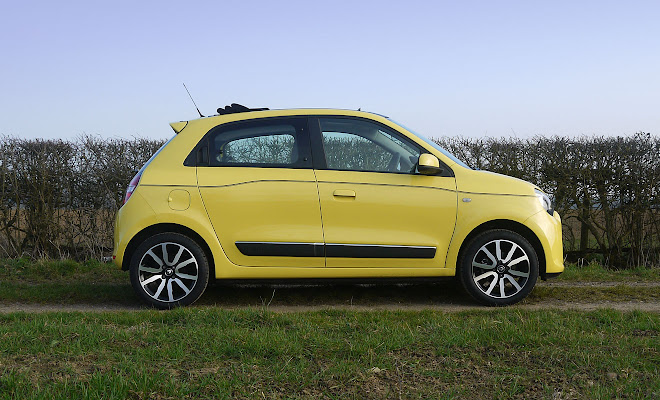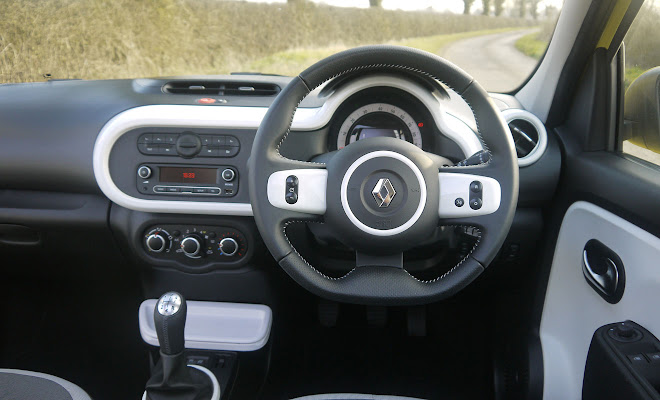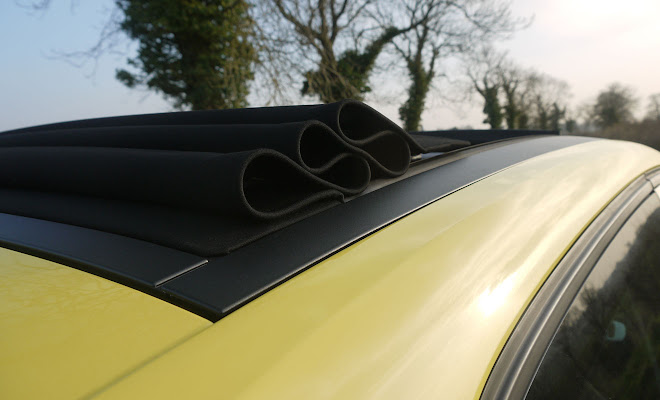by Lem Bingley 
I set off at 6:30, just ahead of the Friday morning rush, so the traffic is thick but hasn’t yet gelled into 7am soup. Slotted into the longest of its five manual gears, the little Twingo keeps up easily with the flow of early commuters – though fourth is a must for slicing cleanly into smaller gaps. Having an exterior the colour of angry wasps and tinned custard also helps – the car is hard to ignore even if you’re half asleep.
And I should have downed another coffee myself, given how restful the cabin feels. The seats are firmly comfortable and the driving position good, even if the wheel only adjusts up and down but not in or out. Wind rustle is as soft as a lullaby, and tyre roar only bites you in the ear over those stretches of motorway surfaced in white-noise concrete. Tunnels are another matter, though. My Twingo is fitted with a foldaway fabric roof and the cacophony of roaring traffic and rumbling lorries bounces around inside the tunnel before zipping straight through the fabric and into my eardrums. It comes as a shock after the serenity a few yards beforehand.

The long gearing, which keeps engine revs low and noise down, also cuts thirst – a remarkable 48mpg and still improving is the car’s own verdict at the end of my M1 stint. That’s a long way from the official 67.3mpg of the combined cycle, but still impressive for a petrol-powered four-seater driven at middling motorway pace. The CO2 rating for my particular Twingo – an SCe 70 fitted with Stop & Start – is 95g/km.
That said, the car itself may be overestimating its real-time economy, given that its speedometer reads a solid 5mph over the odds when my portable satnav reckons 70 to 71. That’s a slightly bigger discrepancy than I’ve witnessed before.
One big reason for the quiet cabin must be the tendency to leave engine noise behind me. Unlike almost every other car on the road, the Twingo carries its engine in the boot. Or more accurately under it. The carpet in the luggage compartment is backed by an inch-thick layer of insulating foam, below which is a painted steel cover, bolted shut. Under that is the engine, lying supine and fitting roughly within the arc of the rear wheels.

As a consequence, the boot is high-set and small, swallowing only 188 litres with the rear seats in use. However, by way of context, the Toyota Aygo’s boot comes in at just 168 litres. And happily, despite the proximity of hot whirling metal, the boot doesn’t behave like a mobile oven. After two hours of motorway slog my luggage arrives no warmer than my toes.
Alas there’s no additional storage under the Twingo’s stubby nose, but you can flip the back seats forward (they’re split 50:50) to yield an almost cavernous 980 litres (or about 200 more than a similarly flipped Citroen C1). You can also stow small items under the rear seat bases, and some Twingo trim levels include a forward-flopping front seat, in case you regularly need to transport a double bass or grandfather clock.
There are two engine options, both three-cylinder petrol units of less than 1.0-litre capacity, and both shared with the mechanically similar new Smart Fortwo and Forfour. One employs a turbocharger to produce a peak of 90 horsepower, but the unboosted engine in my banana-coloured Twingo makes do with 20 fewer horses. As a result it’s a slug on paper: 14.5 seconds to 62mph versus 10.8 for the turbo Twingo.

Personally, I didn’t think the lower-powered Twingo feels too slow, offering a reasonable trade-off between pace and fuel efficiency. The less powerful engine is also £700 cheaper to buy, and five groups lower to insure, rated at 2 or 3 according to trim. Those groups can make a difference. I sought fully comprehensive quotes from More Than car insurance for a 25-year-old male parking on the street in East London, which came in at just under £1,000 a year for the 70bhp Twingo Dynamique in the pictures, and about £250 more for the quicker car.
Either Twingo should make light work of choked city streets. Softish suspension that can feel a little untamed on a country road makes light work of cobbles, pot-holes and sleeping policemen. With the engine out of the way the front wheels are free to turn out to 45 degrees, making parking a doddle and yielding a turning circle about the size of a Polo mint.

The chunky steering wheel spins easily, the gearchange is a little stiff but otherwise clean, and the long-travel clutch has a very easy to chew biting point (though sadly there’s little room to rest your foot when you’ve finished). The brake pedal feels alarmingly soft at first stab, but there is plenty of actual stopping power on the end of it. I imagine the Twingo would be a very forgiving car for learner drivers or others with clumsy feet.
Rear seat accommodation is surprisingly generous. With its 15-inch wheels pushed out to the Twingo’s extremities, and with that little button nose up front, there’s an unusually large proportion of small car given over to people. There’s more room for limbs and knees than in some cars supposedly a size above. All Twingos have five-doors – rear handles are hidden – and the back windows pop out rather than rolling down. But that’s a glazing corner that’s cut even by Volkswagen’s Up.

Up front, the Renault feels remarkably tall and airy for a city car, especially with the electric canvas roof of my test vehicle. An £850 option, it opens up a vast section of sky and operates at motorway speeds. Whisking it aside takes about 10 seconds and the cover can be halted part open if you prefer.
The fabric roof is not noisy when closed, and there’s a flip-up lip to tame turbulence at speed, though the air in the cabin will resonate annoyingly if you drive too fast with the roof open and the windows up. I’m not sure when folding roofs became essential kit for city transport, but the opening fabric option in a Citroen C1 costs precisely the same and comes with identical foibles.

Taller front-seat passengers may notice that they’ve lost a little leg-room. The Twingo’s emergency tyre inflation kit has been stuffed behind a false bulkhead in the footwell, and unfortunately there’s no option to carry even a skinny spare wheel in the new Twingo.
The little Renault offers up excellent all-round vision – as long as it’s not raining. In my particular Twingo at least, the driver’s side wiper stopped about five centimetres shy of the screen pillar, making for a broader than necessary blind spot in foul weather.
Despite these little caveats, I developed a very strong fondness for the Twingo. It helps that it looks great, in equal parts chunky and cheeky. The curvy pinstripe along the side is a bit of a cheat – the car’s flanks are not nearly as flared over the arches as the line might suggest – but the wheel-at-each-corner stance is real, and there’s a surprisingly solid feel for a car that weighs only 864kg.

The interior is equally persuasive, with sensible storage, stylish shapes, readable instruments and materials that feel better than expected for the price. A clever detachable phone cradle plus a scattering of USB slots seems like a much better bet than a low-quality touchscreen, especially given how many phones provide navigation free of charge.
At the end of my week with the Twingo I felt genuinely sorry to see it go. It really is a small car with a big personality. And that’s not something I can honestly say for many of its closest rivals.


Renault Twingo
Rating: stars
Good: spacious, comfortable, quiet
Bad: small boot, not fast, lazy wipers
Price: from £9,495
For a compact urban runabout, the new Twingo feels like a surprisingly capable cruiser. My first drive of any consequence in Renault’s compact city car is a 100-mile, two-hour trip from Leytonstone to Silverstone, pounding around the M25 and up the M1. The journey is unexpectedly stress free. Rating: stars
Good: spacious, comfortable, quiet
Bad: small boot, not fast, lazy wipers
Price: from £9,495
I set off at 6:30, just ahead of the Friday morning rush, so the traffic is thick but hasn’t yet gelled into 7am soup. Slotted into the longest of its five manual gears, the little Twingo keeps up easily with the flow of early commuters – though fourth is a must for slicing cleanly into smaller gaps. Having an exterior the colour of angry wasps and tinned custard also helps – the car is hard to ignore even if you’re half asleep.
And I should have downed another coffee myself, given how restful the cabin feels. The seats are firmly comfortable and the driving position good, even if the wheel only adjusts up and down but not in or out. Wind rustle is as soft as a lullaby, and tyre roar only bites you in the ear over those stretches of motorway surfaced in white-noise concrete. Tunnels are another matter, though. My Twingo is fitted with a foldaway fabric roof and the cacophony of roaring traffic and rumbling lorries bounces around inside the tunnel before zipping straight through the fabric and into my eardrums. It comes as a shock after the serenity a few yards beforehand.

The long gearing, which keeps engine revs low and noise down, also cuts thirst – a remarkable 48mpg and still improving is the car’s own verdict at the end of my M1 stint. That’s a long way from the official 67.3mpg of the combined cycle, but still impressive for a petrol-powered four-seater driven at middling motorway pace. The CO2 rating for my particular Twingo – an SCe 70 fitted with Stop & Start – is 95g/km.
That said, the car itself may be overestimating its real-time economy, given that its speedometer reads a solid 5mph over the odds when my portable satnav reckons 70 to 71. That’s a slightly bigger discrepancy than I’ve witnessed before.
One big reason for the quiet cabin must be the tendency to leave engine noise behind me. Unlike almost every other car on the road, the Twingo carries its engine in the boot. Or more accurately under it. The carpet in the luggage compartment is backed by an inch-thick layer of insulating foam, below which is a painted steel cover, bolted shut. Under that is the engine, lying supine and fitting roughly within the arc of the rear wheels.

As a consequence, the boot is high-set and small, swallowing only 188 litres with the rear seats in use. However, by way of context, the Toyota Aygo’s boot comes in at just 168 litres. And happily, despite the proximity of hot whirling metal, the boot doesn’t behave like a mobile oven. After two hours of motorway slog my luggage arrives no warmer than my toes.
Alas there’s no additional storage under the Twingo’s stubby nose, but you can flip the back seats forward (they’re split 50:50) to yield an almost cavernous 980 litres (or about 200 more than a similarly flipped Citroen C1). You can also stow small items under the rear seat bases, and some Twingo trim levels include a forward-flopping front seat, in case you regularly need to transport a double bass or grandfather clock.
There are two engine options, both three-cylinder petrol units of less than 1.0-litre capacity, and both shared with the mechanically similar new Smart Fortwo and Forfour. One employs a turbocharger to produce a peak of 90 horsepower, but the unboosted engine in my banana-coloured Twingo makes do with 20 fewer horses. As a result it’s a slug on paper: 14.5 seconds to 62mph versus 10.8 for the turbo Twingo.

Personally, I didn’t think the lower-powered Twingo feels too slow, offering a reasonable trade-off between pace and fuel efficiency. The less powerful engine is also £700 cheaper to buy, and five groups lower to insure, rated at 2 or 3 according to trim. Those groups can make a difference. I sought fully comprehensive quotes from More Than car insurance for a 25-year-old male parking on the street in East London, which came in at just under £1,000 a year for the 70bhp Twingo Dynamique in the pictures, and about £250 more for the quicker car.
Either Twingo should make light work of choked city streets. Softish suspension that can feel a little untamed on a country road makes light work of cobbles, pot-holes and sleeping policemen. With the engine out of the way the front wheels are free to turn out to 45 degrees, making parking a doddle and yielding a turning circle about the size of a Polo mint.

The chunky steering wheel spins easily, the gearchange is a little stiff but otherwise clean, and the long-travel clutch has a very easy to chew biting point (though sadly there’s little room to rest your foot when you’ve finished). The brake pedal feels alarmingly soft at first stab, but there is plenty of actual stopping power on the end of it. I imagine the Twingo would be a very forgiving car for learner drivers or others with clumsy feet.
Rear seat accommodation is surprisingly generous. With its 15-inch wheels pushed out to the Twingo’s extremities, and with that little button nose up front, there’s an unusually large proportion of small car given over to people. There’s more room for limbs and knees than in some cars supposedly a size above. All Twingos have five-doors – rear handles are hidden – and the back windows pop out rather than rolling down. But that’s a glazing corner that’s cut even by Volkswagen’s Up.

Up front, the Renault feels remarkably tall and airy for a city car, especially with the electric canvas roof of my test vehicle. An £850 option, it opens up a vast section of sky and operates at motorway speeds. Whisking it aside takes about 10 seconds and the cover can be halted part open if you prefer.
The fabric roof is not noisy when closed, and there’s a flip-up lip to tame turbulence at speed, though the air in the cabin will resonate annoyingly if you drive too fast with the roof open and the windows up. I’m not sure when folding roofs became essential kit for city transport, but the opening fabric option in a Citroen C1 costs precisely the same and comes with identical foibles.

Taller front-seat passengers may notice that they’ve lost a little leg-room. The Twingo’s emergency tyre inflation kit has been stuffed behind a false bulkhead in the footwell, and unfortunately there’s no option to carry even a skinny spare wheel in the new Twingo.
The little Renault offers up excellent all-round vision – as long as it’s not raining. In my particular Twingo at least, the driver’s side wiper stopped about five centimetres shy of the screen pillar, making for a broader than necessary blind spot in foul weather.
Despite these little caveats, I developed a very strong fondness for the Twingo. It helps that it looks great, in equal parts chunky and cheeky. The curvy pinstripe along the side is a bit of a cheat – the car’s flanks are not nearly as flared over the arches as the line might suggest – but the wheel-at-each-corner stance is real, and there’s a surprisingly solid feel for a car that weighs only 864kg.

The interior is equally persuasive, with sensible storage, stylish shapes, readable instruments and materials that feel better than expected for the price. A clever detachable phone cradle plus a scattering of USB slots seems like a much better bet than a low-quality touchscreen, especially given how many phones provide navigation free of charge.
At the end of my week with the Twingo I felt genuinely sorry to see it go. It really is a small car with a big personality. And that’s not something I can honestly say for many of its closest rivals.




